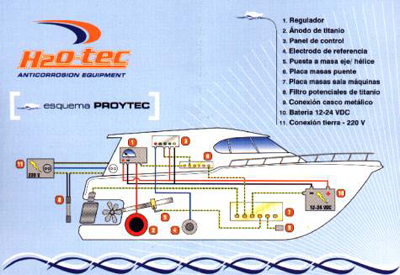The submerged portion of a boat includes:
The equipment consist of:
To inject positive current into the water, we need a non-sacrificial anode (one that does not destroy itself such as in the case of Zinc anodes), one that does not become passive when positive current flows to the water. For this reason we use activated titanium anodes, which not only meet this criteria, but will also work for 20 or more years.
The other half of the system includes the regulator, which is mounted in a clearly visible location on the bridge. The regulator is responsible for administering continuous current to (in all circumstances) all the submerged metallic surfaces in their corresponding amounts in order to keep them immune from electrolysis. These regulators incorporate power saving technologies to minimize the drain on the battery.
A reference electrode is mounted in the hull of the boat and gives continuous information about the status of protection of all submerged metallic parts. The signal from the reference electrode goes to a microprocessor that in turn translates the information and displays the status through the use of 12 colored LEDs (control panel). The (control panel), located on the bridge, gives continuous information about the status of cathodic protection throughout the boat.
Shafts and propellers deserve special attention because that is where most of the corrosion takes place. To ensure that negative electric protection current reaches all parts of the submerged metal, especially the shafts and propellers, Proytec includes in each kit, a grounding shaft ring and brush, which ensure constant contact with the moving shaft.
In the diagram above, all installed components and connections can be seen.
We can see how all submerged metallic parts are connected to the grounding plate in the engine room. In this case the boat is made of fiberglass and therefore the hull is not connected to the grounding plate. In the case of metal or aluminium boats, the hull would also need to be connected to the grounding plate.
In the case of fishing or patrol boats, the connections would be very similar to those shown above. The metals that are connected are protected; therefore it is very important that the connections be properly made.

Note: For more information, contact your nearest distributor.